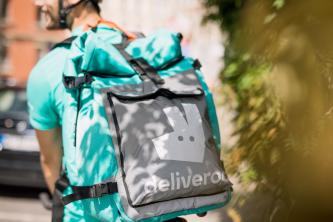
With the general uberization of the economy and evolutions in consumer practices, meal delivery services have grown significantly in recent years. With the Covid pandemic driving the increase in the number of restaurants and clients using delivery services, many delivery riders have signed up, looking for an easy income and an autonomous and flexible job. They work for digital platforms such as Uber Eats or Deliveroo that now employ over ten thousand delivery drivers in France. As such, the drivers have truly become key players in urban logistics. How do they experience this mobile profession? Being a bike delivery rider today: passion or exploitation?
In recent years and especially since the start of the pandemic, the use of home meal delivery services has exploded. With the uberization of the economy, delivery platforms (Uber, Deliveroo, Frichti, etc.) have recruited many delivery workers by promising them an easy income and independence. Do these advantages, advertised by the platforms, become reality? While bike delivery riders are now clearly visible in the public space, do we really know who they are? What are their working conditions? How much time do they spend roaming cities each day and for how much money? How do they experience this mobile profession? Being a bike delivery rider today: passion or exploitation?
The Mobile Lives Forum asked a group of students in the Master’s programme in Planning and Urbanism at the University of Paris 1 to examine these questions. They conducted 53 in-depth interviews with delivery drivers working in the centre of Paris and in the outer suburbs (Mantes-la-Jolie), as well as making observations and holding a focus group resulting in a series of proposals to better understand the problems encountered by delivery workers.
In their early days, platforms that needed to recruit labour offered advantageous working conditions to attract delivery riders working mainly as micro-entrepreneurs: autonomous activity, flexible hours, well-paid and outdoor work, friendly events, etc.
Initially, there were relatively few delivery riders, mostly young French students, often cycling enthusiasts, working part-time in search of supplementary income. But new profiles have progressively emerged in the profession as the wage conditions have gotten stricter and platforms have increased their demands: pressuring workers to go faster, deteriorating working conditions, reducing the pay, etc. For example, in September 2020, delivery riders working for Uber Eats received a gross average of 8.7 euros per hour, compared to 9.9 euros six months earlier; by comparison, the hourly gross minimum wage in France is 10.15 euros. Some platforms (Deliveroo in 2017) have even gone from pay per hour to pay per delivery and pay per kilometre travelled. Before this measure was adopted, delivery drivers were paid 7.5 euros per hour and received between 2 and 4 euros per delivery. Now, Deliveroo riders are paid 2 euros when picking up the order, 1 euro when dropping it off and a supplement depending on the distance travelled. Pay per delivery responds to a gig economy in which waiting time is no longer remunerated, even though delivery workers sometimes spend more time waiting for orders than delivering. To generate a sufficient income, delivery riders must therefore go as fast as possible, in order to complete more deliveries and/or cover longer distances.
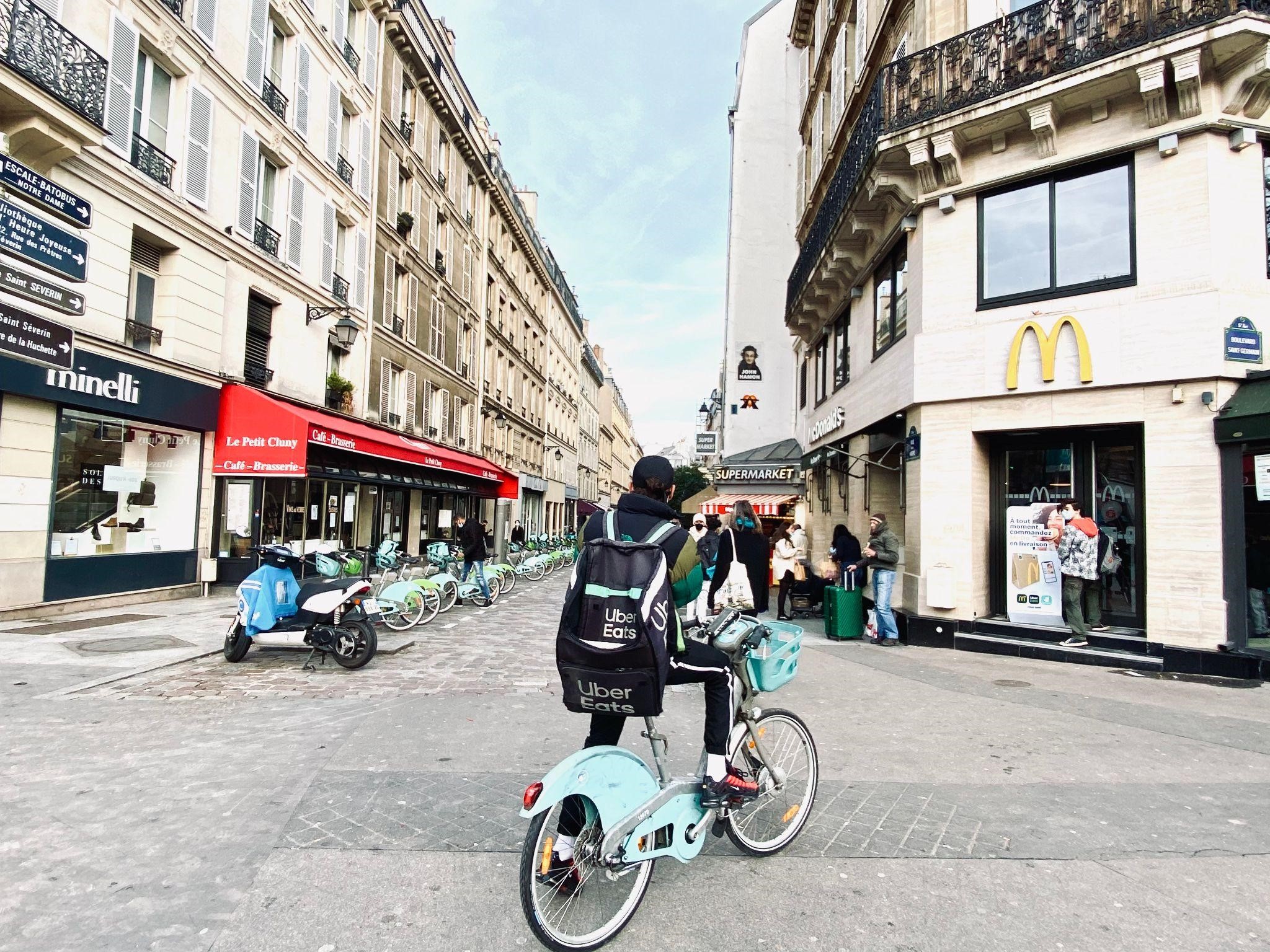
A delivery rider on a Vélib in rue de la Harpe (5th arrondissement)
Platforms can afford to change their policy in this way because there are today far more delivery riders working for them than before, and most are highly dependent on the income they get from it. Many started delivering following the loss of a previous job. This trend has been amplified by the pandemic, which on the one hand caused many job cuts, while simultaneously generating an increased demand for home delivery services on the other.
Many people in precarious situations, including migrants - some undocumented - have taken up this easily accessible activity: there is little or no selection process to get hired, and no need for special training. This has led to greater diversity in the profiles of delivery workers as well as to increased competition among drivers, and even to subcontracting between them, going as far as exploitation (i.e. registered drivers subletting their account to non-registered workers in exchange for a commission they set).
The 53 delivery drivers interviewed by the students travel on average between 40 and 120 km per working day. But in reality, their situations are varied. Among the respondents, there are:

Paul, a delivery driver belonging to the “couriers” category
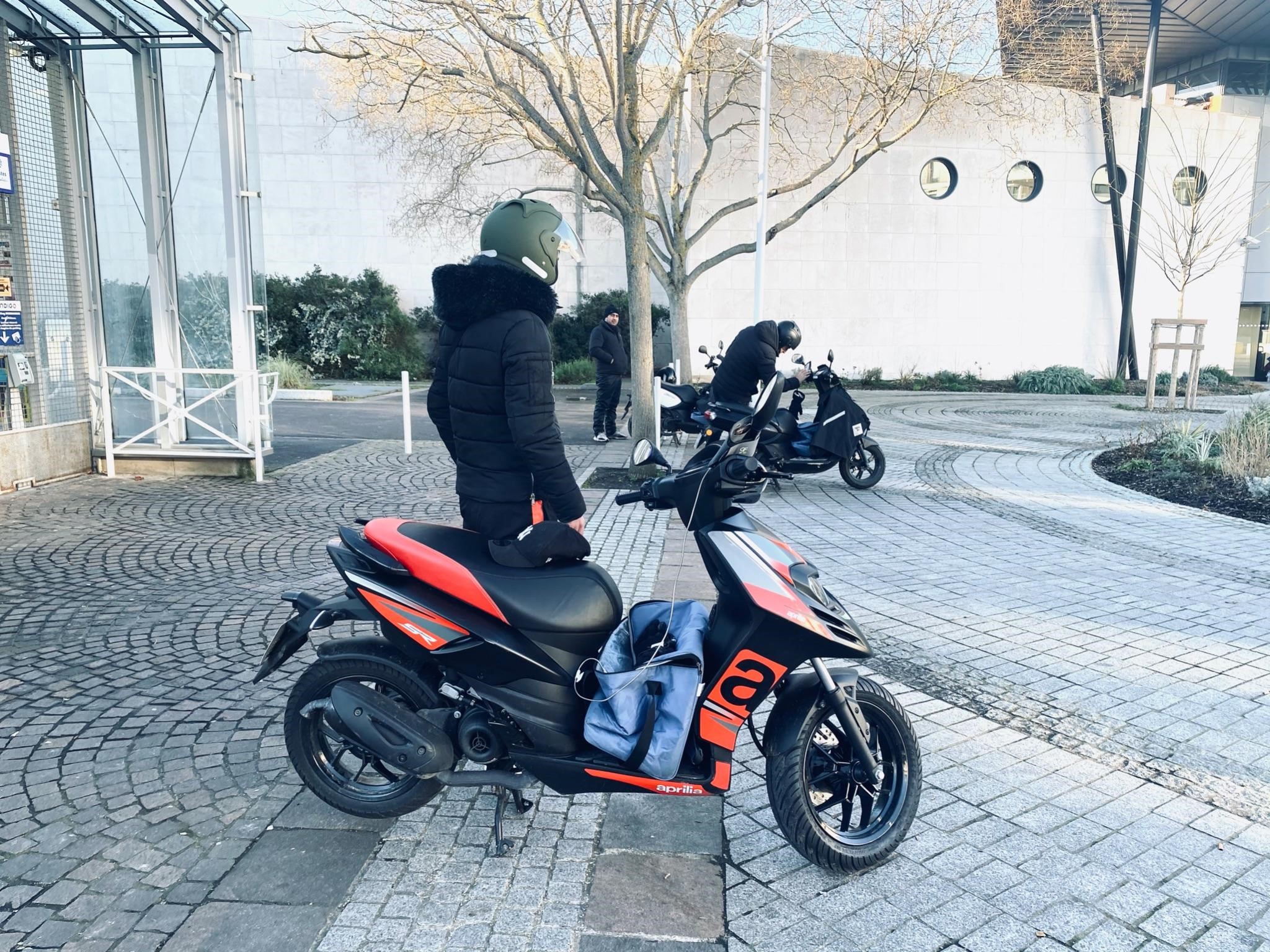
Ali, a delivery driver belonging to the "slaves" category
The daily life of delivery workers, while very uncertain, is also highly mobile, with platforms always pressuring them to go faster, especially through incentive systems that reward the most effective delivery riders and penalize the slower ones. In the outer suburbs, riders commonly have to travel long distances and use fast traffic lanes to cater to the many predominantly residential municipalities that don’t have restaurants.
Because of the resulting physical fatigue and risk-taking, many delivery riders use a scooter or a car, both of which require a specific license to perform deliveries – which, incidentally, calls into question the positive environmental impact of bicycle delivery services.
More generally, as the respondents spend their working days in a race against the clock (spurred on by the fee system), their cohabitation with other users of the public space can be a source of tension and even collisions. The issue of delivery drivers not complying with traffic rules (using pedestrian streets, running red lights, etc.) further increases these risks.
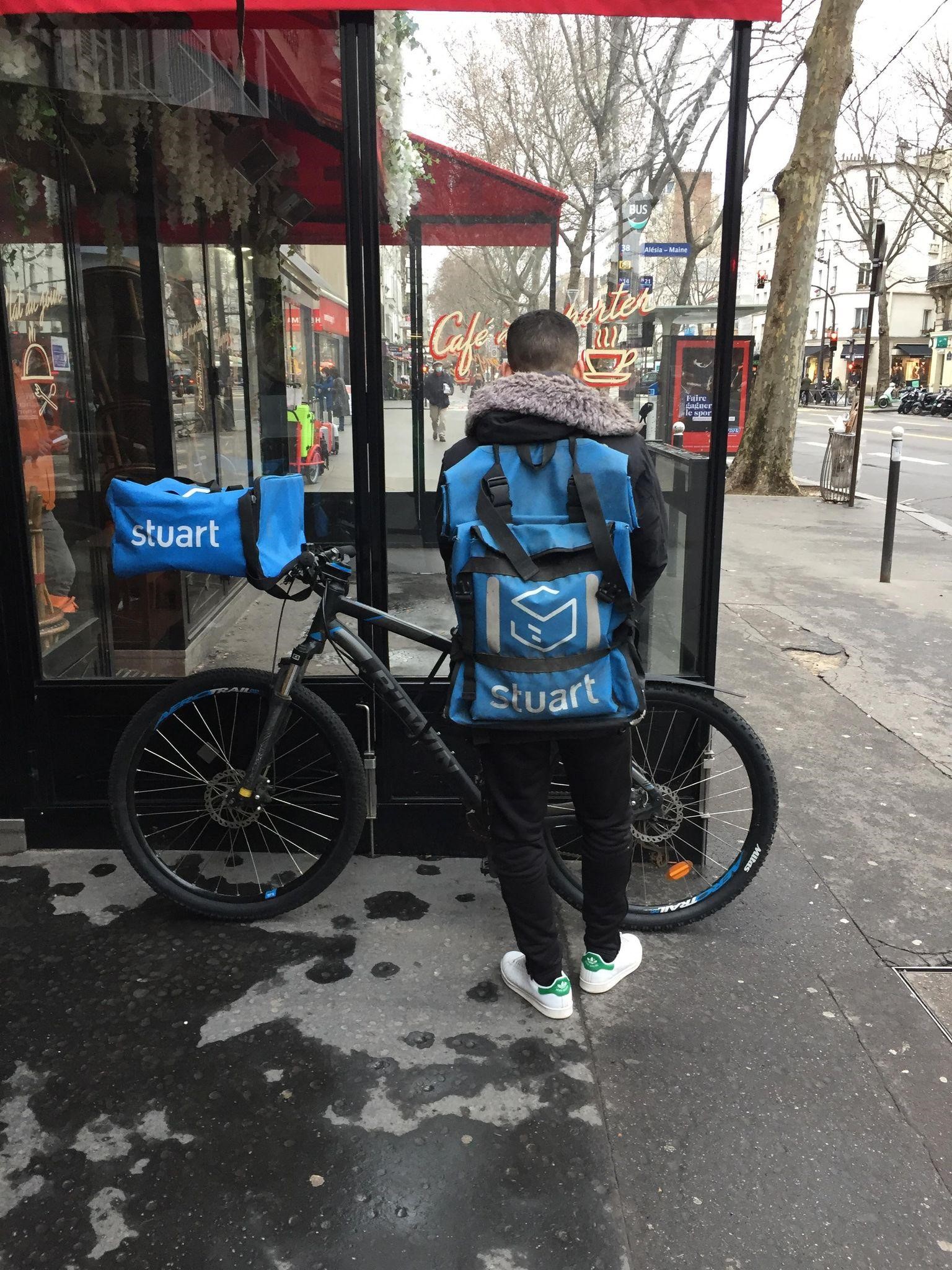
Toufik, a delivery driver belonging to the "slaves" category
The delivery workers in the survey reported using a variety of vehicles: different types of bicycles (mechanical, electric, Vélib, Véligo, etc.) (40/53), cars (5/53), and scooters (13/53). Some use more than one type of vehicle and commonly switch from one vehicle to another throughout their careers. And the vehicle they choose can greatly modify how they experience their work. Indeed, depending on whether they are using a car, a scooter, or a bicycle, they accept orders of varying lengths, drive in a certain way, and travel at different speeds.
The students established a typology of how delivery drivers relate to bicycles, considering their degree of attraction/rejection towards them, and their use of other means of transport to perform deliveries and get around. Six profiles were thus identified:
• The “couriers” (10/53): they are part of a community structured around the professional practice of cycling. They enjoy working on a bicycle and cycling itself is experienced as a way of life. • The “bicycle enthusiasts” (7/53): they already liked cycling before becoming delivery workers, and they now ride a bike on a regular basis in their daily life. • The “bicycle converts” (4/53): before working in deliveries, they rarely - if ever - cycled. But as they gained experience in this profession, they developed a liking for it. • The “moderate athletes” (8/53): they see their job as an opportunity to work out. As a result, they like to ride a bicycle during their working time, but don’t cycle in their private time. • The “tired of cycling” (18/53): they are tired of riding a bicycle to make deliveries. They have therefore changed their mode of transport or wish to do so, to switch to an electric bike, a scooter or a car. • The "motorized drivers" (6/53): they’ve always used a motor vehicle and don’t want to switch to a bicycle because of the inconveniences: the cold, bad weather, risk of accident and physical exhaustion.
The daily life of delivery drivers is also made worse by their lack of relations with the platform they work for, as they receive orders from an algorithm. Yet, in the early days of this industry, some platforms created ambassadors - delivery workers who were distinguished by the platform and responsible for part of the recruitment and training of new delivery workers.
Not only is their work dehumanized, but the algorithm and its functioning are opaque, making the pay uncertain. Additionally, the idle time spent waiting for an order - something which is inherent to this line of work - is a source of anxiety, insofar as in most cases, it is unpaid. It is also a source of discomfort: delivery workers don’t have a dedicated place to go to the toilet, rest, or shelter from bad weather. Some delivery workers remain stationary near restaurants known to receive many orders, while others ride or drive in the hope of getting closer to areas with more restaurants and customers. For some, this waiting time is an opportunity to socialize, affording them some comfort in the midst of their difficult working conditions.
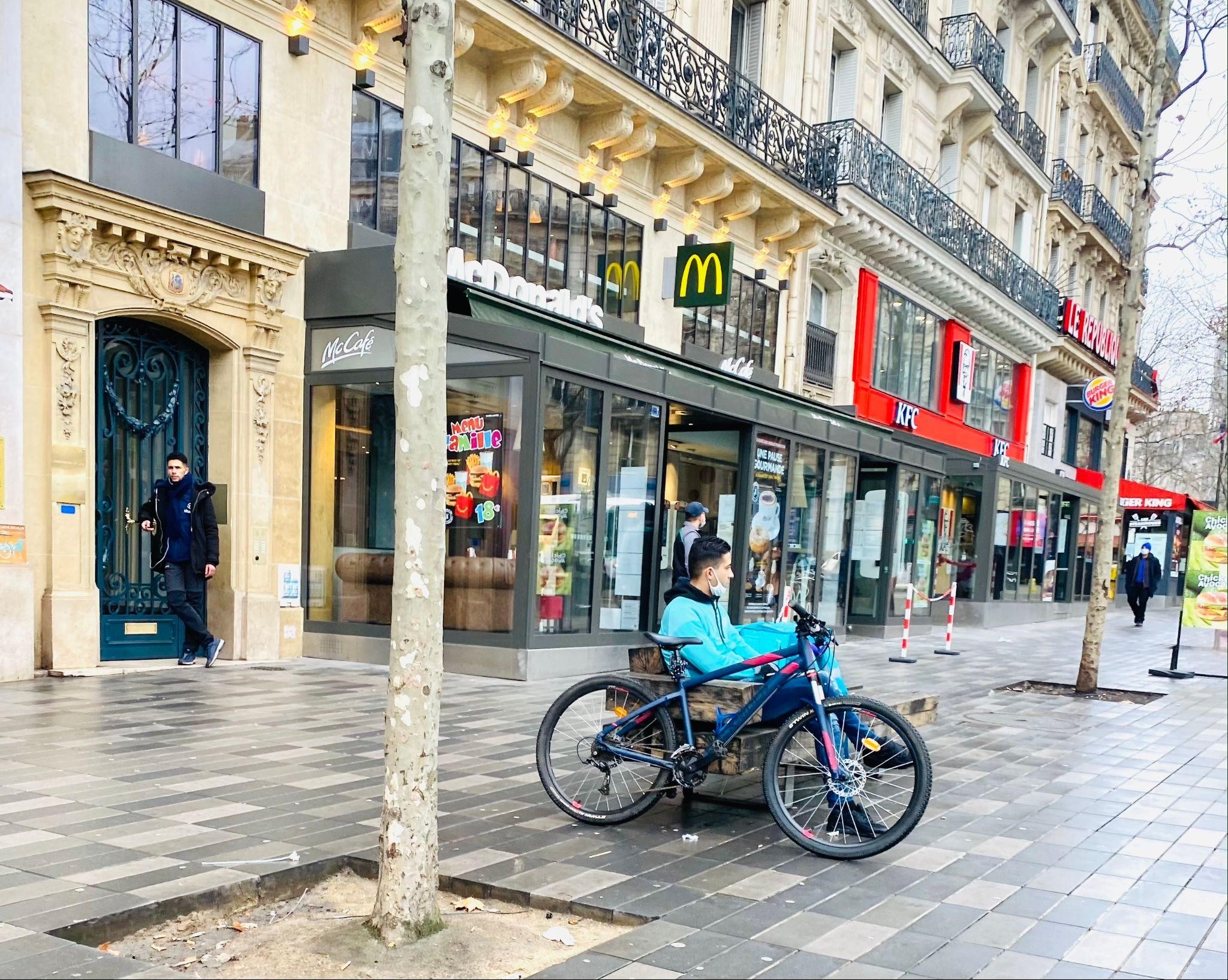
A delivery man waiting on a bench at Place de la République, close to fast food restaurants
The presence of food delivery workers in the media and in the public space is gradually encouraging conversations and a better understanding of the precariousness of thousands of delivery workers who aren’t benefitting from the rights normally guaranteed under the Labour Code.
At the end of a focus group with delivery workers, the students conclude their research with a series of recommendations that relate to both labour legislation and urban planning.
Download the synthesis (In French only)
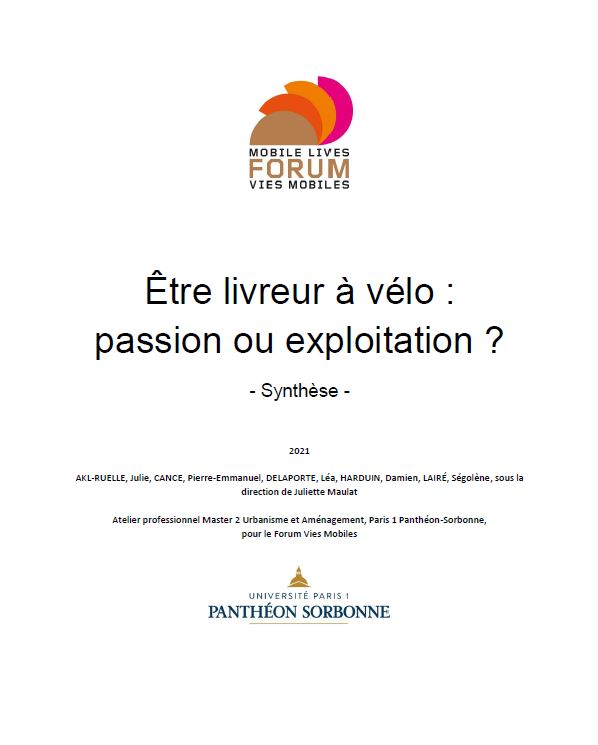
Download the full report (in French only)

Also check out the virtual exhibition GigWork, by researchers Cosmin Popan and Nathanael Sheehan, and artists Oana Lohan, Ionuț Dulămiță, José Sherwood González and Alin Tămășan, based on research carried out on bicycle delivery workers in Manchester, Cluj and Lyon: https://gigwork.city/
Policies
To cite this publication :
Juliette Maulat et Master 2 Aménagement du Territoire et Urbanisme Université Paris 1 2020-2021 (14 December 2020), « Being a bicycle delivery rider: passion or exploitation? », Préparer la transition mobilitaire. Consulté le 26 April 2025, URL: https://forumviesmobiles.org./en/project/13524/being-bicycle-delivery-rider-passion-or-exploitation

Projects by Forum Vies Mobiles are licensed under a Creative Commons Attribution-NonCommercial-ShareAlike 3.0 France License.
Permissions beyond the scope of this license may be available at contact.
Other publications